MSI Z97 Guard-Pro Review: Entry Level Z97 at $110
by Ian Cutress on August 20, 2014 6:00 AM EST- Posted in
- Motherboards
- Intel
- MSI
- Z97
System Benchmarks
Power Consumption
Power consumption was tested on the system while in a single MSI GTX 770 Lightning GPU configuration with a wall meter connected to the OCZ 1250W power supply. This power supply is Gold rated, and as I am in the UK on a 230-240 V supply, leads to ~75% efficiency > 50W, and 90%+ efficiency at 250W, suitable for both idle and multi-GPU loading. This method of power reading allows us to compare the power management of the UEFI and the board to supply components with power under load, and includes typical PSU losses due to efficiency. These are the real world values that consumers may expect from a typical system (minus the monitor) using this motherboard.
While this method for power measurement may not be ideal, and you feel these numbers are not representative due to the high wattage power supply being used (we use the same PSU to remain consistent over a series of reviews, and the fact that some boards on our test bed get tested with three or four high powered GPUs), the important point to take away is the relationship between the numbers. These boards are all under the same conditions, and thus the differences between them should be easy to spot.
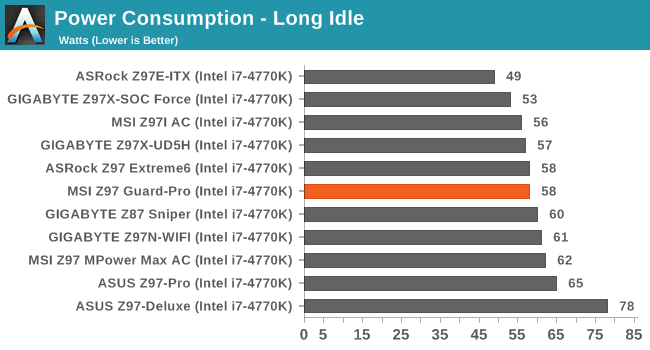

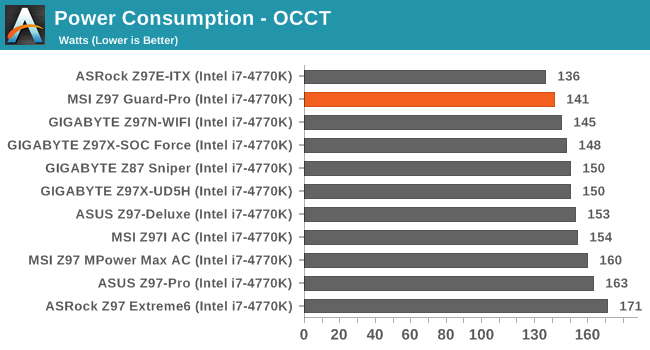
141W for full load gives the Z97 Guard-Pro a good result.
Windows 7 POST Time
Different motherboards have different POST sequences before an operating system is initialized. A lot of this is dependent on the board itself, and POST boot time is determined by the controllers on board (and the sequence of how those extras are organized). As part of our testing, we look at the POST Boot Time using a stopwatch. This is the time from pressing the ON button on the computer to when Windows 7 starts loading. (We discount Windows loading as it is highly variable given Windows specific features.)
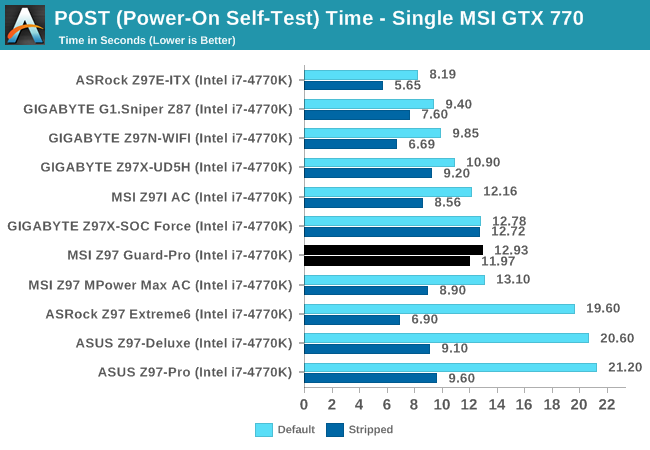
We still have an odd scenario with Z97 being reasonably high with POST times on average. With Intel’s 8-series, 12 seconds was a good benchmark; the Z97-Guard Pro ran 13 seconds at standard and 12 seconds when stripped.
Rightmark Audio Analyzer 6.2.5
Rightmark:AA indicates how well the sound system is built and isolated from electrical interference (either internally or externally). For this test we connect the Line Out to the Line In using a short six inch 3.5mm to 3.5mm high-quality jack, turn the OS speaker volume to 100%, and run the Rightmark default test suite at 192 kHz, 24-bit. The OS is tuned to 192 kHz/24-bit input and output, and the Line-In volume is adjusted until we have the best RMAA value in the mini-pretest. We look specifically at the Dynamic Range of the audio codec used on board, as well as the Total Harmonic Distortion + Noise.
Dynamic Range of the Z97 Guard-Pro
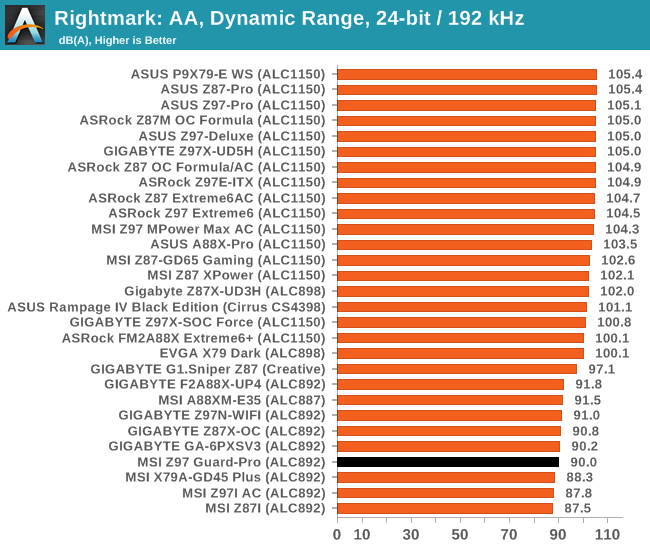
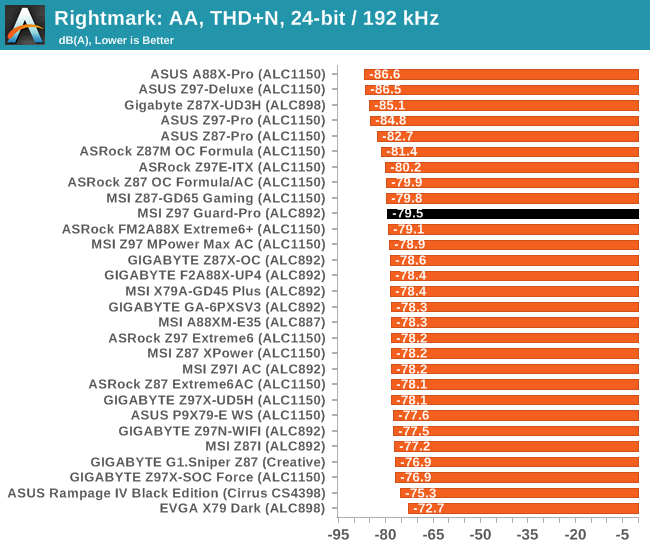
The ALC892 codec is not the best of Realtek’s lineup, and on the Z97 Guard-Pro it does not perform to the best of its ability in the dynamic range, which seems to be a common issue on MSI motherboards.
USB Backup
For this benchmark, we transfer a set size of files from the SSD to the USB drive using DiskBench, which monitors the time taken to transfer. The files transferred are a 1.52 GB set of 2867 files across 320 folders – 95% of these files are small typical website files, and the rest (90% of the size) are small 30 second HD videos. In an update to pre-Z87 testing, we also run MaxCPU to load up one of the threads during the test which improves general performance up to 15% by causing all the internal pathways to run at full speed.
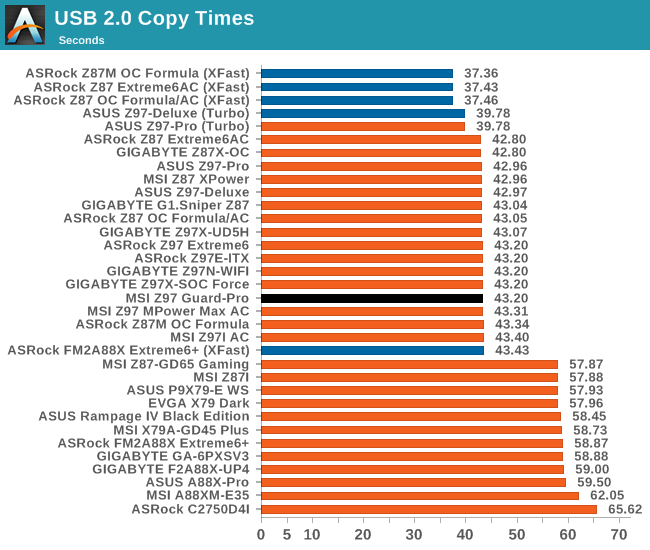
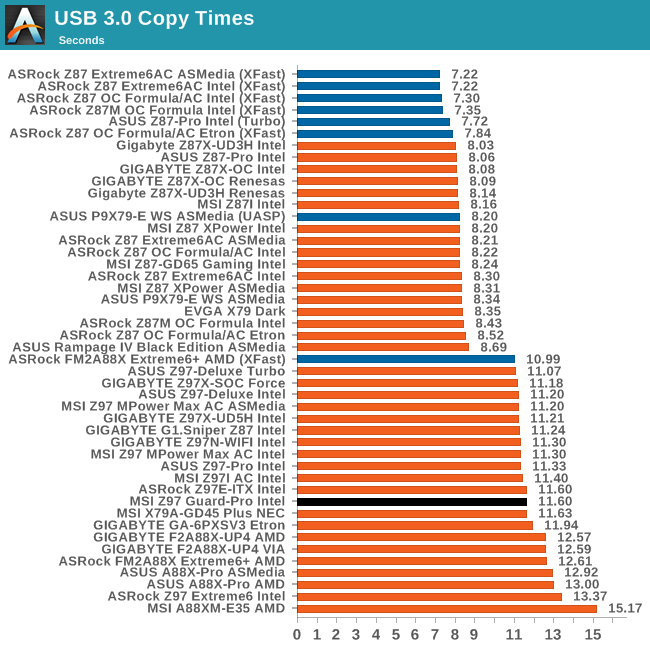
With a lower cost motherboard one might expect a regression in performance against the high end, but in the USB performance graphs at least, the MSI Z97 Guard-Pro is in the mix witht he other Z97 motherboards.
DPC Latency
Deferred Procedure Call latency is a way in which Windows handles interrupt servicing. In order to wait for a processor to acknowledge the request, the system will queue all interrupt requests by priority. Critical interrupts will be handled as soon as possible, whereas lesser priority requests such as audio will be further down the line. If the audio device requires data, it will have to wait until the request is processed before the buffer is filled.
If the device drivers of higher priority components in a system are poorly implemented, this can cause delays in request scheduling and process time. This can lead to an empty audio buffer and characteristic audible pauses, pops and clicks. The DPC latency checker measures how much time is taken processing DPCs from driver invocation. The lower the value will result in better audio transfer at smaller buffer sizes. Results are measured in microseconds.
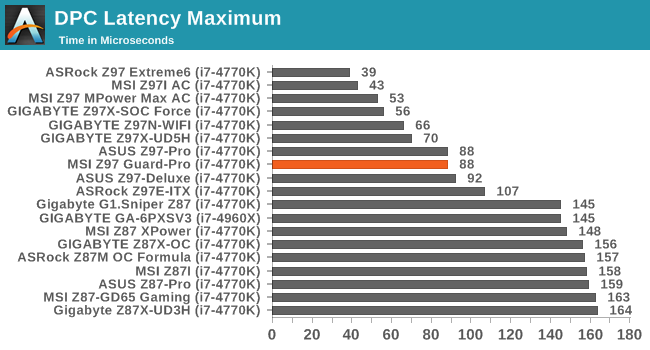
DPC Latency with Intel’s 9-series continues to be a positive feature of the chipset with the Guard-Pro scoring under 100 microseconds.











41 Comments
View All Comments
Samus - Thursday, August 21, 2014 - link
Definitely agree about the Core 2's. Anything pre-Bloomfield is showing its age. But there is a subtle but noticeable difference between a Pentium Haswell and a Core i3 Haswell when using Windows 8/Office 2013, especially in Outlook and Access (programs that deal with large data files)Flunk - Wednesday, August 20, 2014 - link
I think it would match better with a i5 4670k, you're better off buying one of the few H-series boards that support overclocking the Pentium AE and saving the rest. If you're paying more for your board than your CPU you have a problem.Computer Bottleneck - Wednesday, August 20, 2014 - link
I'm glad Ian reviewed this board. It is very pertinent considering it is a board that has been bundled with Pentium G3258.Just less than a week ago the Pentium G3258 was on sale with the MSI Z97 Guard Pro for $110 AR ---> http://forums.anandtech.com/showthread.php?t=23954...
We don't find these kind of deals with the i3 or other Pentiums or Celerons.
Gigaplex - Wednesday, August 20, 2014 - link
It's a bit late to get into GPU bitcoin mining...Shadowmaster625 - Wednesday, August 20, 2014 - link
Ironically, I just got this board in last night, as part of a TD $100 G3258 combo. My G3258 will no go past 4.4GHz @ 1.299V. And the temps hit 92C under full load so upping the voltage isnt really an option. Even though these temps are high, I'm just going to leave it because during my suite of real world tests, the temps stayed below 70C.My main issue with the board is that my ethernet cuts out whenever I plug in any USB device. I have to unplug my LAN and then plug it back in or else it wont work. I tried plugging in a thumb drive as gently as I possibly could and it still caused the LAN to die.
Another annoying issue is that every time I move my SSD to a different SATA port, it makes the board think the overclocking failed, so I have to go back into the BIOS each time and turn it back on.
hojnikb - Wednesday, August 20, 2014 - link
Looks like a defected mobo, if you ask me.kwrzesien - Wednesday, August 20, 2014 - link
As far as the M.2 specs go, straight from the MSI manual:Intel Z97/ H97 Express Chipset
6x SATA 6Gb/s ports (SATA1~6)
1x M.2 port*
M.2 port supports M.2 SATA 6Gb/s module
M.2 port supports M.2 PCIe module up to 10Gb/s speed**
M.2 port supports 4.2cm/ 6cm/ 8cm length module
Supports RAID 0, RAID1, RAID 5 and RAID 10***
Supports Intel Smart Response Technology, Intel® Rapid Start
Technology and Intel Smart Connect Technology****
* The SATA5 and SATA6 ports will be unavailable when installing a module in the M.2 port.
** M.2 PCIe interface only supports UEFI option ROM, NOT support legacy option ROM.
*** M.2 PCIe interface does not support RAID 0, RAID1, RAID 5 and RAID 10.
**** Supports Intel Core processors on Windows 7 and Windows 8/ 8.1
So I don't see anything in the manual about the M.2 disabling any of the PCIe slots, either for SATA or PCIe type M.2 drives - it appears to use the SATA 5 & 6 ports either way. Anyway this is a PCIe 2.0 x2 10MB/s type connection, not x4 and not PCIe 3.0. Still would be very fast with the Plextor PCIe M.2 drives (which oddly cost less than the slower Micron SATA M2. drives): http://www.newegg.com/Product/Product.aspx?Item=N8... It appears that booting is supported natively.
anthill - Wednesday, August 20, 2014 - link
Anandtech should do an article discussing minimum fps. Looking at the bioshock numbers the difference between the best and worst motherboard is 13fps. Even the top board dips below the 30fps threshold that not even a g-sync monitor can help you with. BF4 isn't as significant but one still would be at a ~5fps disadvantage versus picking the top performing motherboards.Is this driver related? Can it be improved upon by opting for faster ram, 2133 vs 1600?
I feel it's a topic they could look into. Especially with VR coming soon I have read a gamer would need to hit a locked 90hz to feel a sense of "presence". These minimum fps benchmarks could become an issue going forward if one wants to hit the target fps needed.
StrangerGuy - Wednesday, August 20, 2014 - link
Why is anybody still running CPU performance benchmarks on mobo reviews in 2014 is beyond me. We would much rather see LPC latency, LAN/USB throughput, audio quality testing etc.lorribot - Wednesday, August 20, 2014 - link
Why is it always assumed that enthusiasts have unlimited funds? Most are probably like me, when it come to replacing the core of our system it is invariably on a restricted budget, not for us a $200 mobo and a $200 CPU. Anything that the mobo manufacturers can do to allow you to upsec the CPU to a K series is very welcome. I really don't care that it is Realtek as Intel will not really make that much difference over my poor adsl internet connection and I can't afford a speaker system that will show the difference between Realtek and Creative or anyone else's sound chips.All I want is a good strong, stable basic mobo that will allow overclocking for the minimum cost, this board gets close to this ideal.